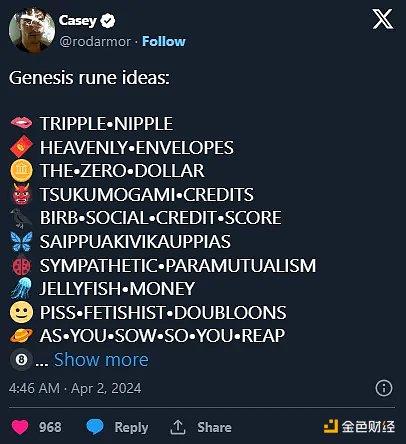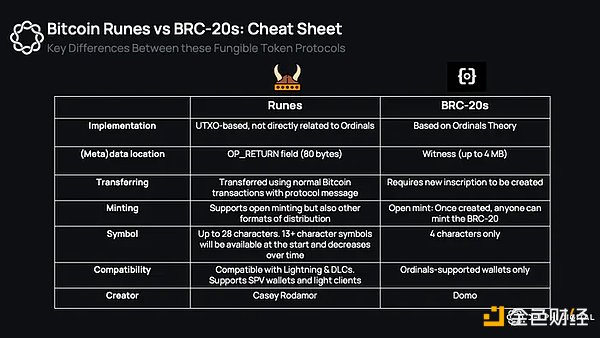Author: Marlon; Translated by: Yangz, Techub News
As the Bitcoin halving approaches, speculators are eagerly awaiting the launch of Runes. While CT has attracted a lot of attention, there has also been a lot of confusion and misinformation surrounding this new token standard. Even unrelated protocols have used "Rune" in their names and tokens, adding to the confusion.
To avoid misleading, we have made a simple summary.
What are Runes?
As a developer at Ordinal Theory, Casey Rodarmor is building a fungible token standard for Bitcoin, the Runes protocol. As a meta-protocol, the Runes protocol is not a token in itself, and as Casey said in the podcast, it is "where people create shitcoins on top of Bitcoin."
Tokens created using this token standard are called Runes. Unlike BRC-20, Runes is a homogeneous token standard, that is, each Rune is interchangeable. The Runes token standard is similar to the ERC-20 token on Ethereum, but simpler.
Overview
Rune Protocol will be launched on April 19th at the halving block
Rune balances are stored in Bitcoin UTXO
The Runes protocol uses Bitcoin's security framework and extends UTXO to store Bitcoin and Rune balances. Therefore, users can create and trade runes through regular Bitcoin transactions.
Runes 0-9 are hardcoded to ensure fair distribution
This is an important nuance. Many protocols are scrambling to launch their own Rune tokens, some through creative gamification models, others through tantalizing promises of airdrops. Be cautious of fake marketing from projects claiming to be the first Runecoin; at best, they can only secure and etch the 11th rune.
The Genesis Rune, Rune 0, will be open for minting, starting from this halving and ending at the next halving in about 4 years. Each minting will receive one Genesis Rune, and the divisibility is zero.
Originally, only 13 or more characters were allowed as rune names.
Approximately every 4 months, the rune name will be reduced by one character. The maximum length of the name is 28 characters. In addition, to prevent "front running", the protocol adopts a "submit first, then disclose" scheme. The unlock schedule of token names can be found here. In short, please be prepared for crazy token names:

Create runes using the OP_Return field
This makes each rune name unique. Additionally, each token will have a single Unicode code point as the currency symbol.
Can Rune replace BRC-20?
With a total market cap of $2.65 billion, BRC-20 tokens have a sizable market share in the Bitcoin market. The narrative surrounding Rune is driven primarily by speculators who believe that Rune will replace BRC-20 as the new widely used token standard on Bitcoin.
Are Runes a Better Token Standard?
As we highlighted in our in-depth look at Ordinals and Runes, the differences between the two are quite stark:

Runes do not use witness data, but instead utilize the OP_RETURN field to simplify the process of creating tokens. Users can etch (deploy), mint, and transfer runes through Runestones, making regular Bitcoin transactions possible.
Runestones are rune protocol messages that store transfer instructions in Bitcoin's unspent transaction outputs (UTXOs). These transfer instructions determine how to transfer runes in outputs, such as the destination address and the transfer amount. By default, the rune balance on the input UTXO is destroyed when it is transferred to a new UTXO.
This approach is more friendly to the network than the BRC-20 standard, which currently generates a large number of unused UTXOs, making the network cluttered. Another disadvantage of BRC-20 is that new inscriptions must be created for each token transfer.
Additionally, runes are more flexible in how they are created. They can be open minted, fair distributed, and users can choose to mint the entire supply into a single address (like ERC-20). BRC-20 is limited to open minting.
More importantly, BRC-20 inscriptions are more prone to front-running. This is because anyone can see the inscription transaction in the mempool and then execute it early by paying a higher transaction fee, which is bound to be troublesome for trying to deploy new tokens. In contrast, Runes attempts to prevent front-running using a "submit first, then disclose" scheme. At a higher level, it is also possible for users to privately commit to transactions. Disclosing details only shortly before confirmation can greatly reduce the time window for front-running.
Finally, Runes supports compatibility with SPV wallets and Bitcoin L2, which uses the UTXO model. Therefore, in theory, it is possible to use lightweight wallets and integrate with the Lightning Network for faster and cheaper transactions. The reason for the emphasis on "in theory" is that although interoperability already exists, the infrastructure must be developed first.
Some FUD
In theory, Runes solves many of the issues that BRC-20 has in terms of user experience and compatibility. However, I am cautious about the view that Runes will indisputably replace BRC-20.
To enable protocol upgrades and ensure clients stay in sync, Casey incorporated what he calls a Cenotaph model into the Runes protocol. Cenotaphs are malformed rune stones created by bad inputs. When included in a transaction, the runes associated with the Cenotaphs are destroyed or unusable.
This is one of the controversial points because it creates the risk of accidentally losing runes. For example, if you interact with an application that creates rune transactions and it accidentally generates a Cenotaph, you could lose all the runes stored in the same UTXO.
So is this risk big or small? It's hard to say before the protocol goes live, but users need to keep this in mind. Casey mentioned these issues in this Thread - TLDR: In his opinion, the risk is negligible. Regardless of its importance, avoiding untested third-party services after Runes is launched is a good way to minimize the risk.
In addition, there have been recent rumors on Twitter that BRC-20 may soon be updated. It is said that the BRC-20 indexer will be able to calculate EVM smart contract code on token balances. If the rumor is true, many current design problems will be solved, making BRC-20 more competitive than Runes. However, it should be noted that this is just a rumor and should be treated with caution.
Ultimately, the success of Runes depends on the user experience. If Runes can be quickly integrated and take advantage of its broad compatibility, it has the potential to replace BRC-20.
If you’re interested in getting a hands-on with Runes before it goes live, check out Haze’s excellent analysis of $PUPs . For more information on the technology, I highly recommend checking out the official documentation and listening to Casey’s podcast about the product launch.
Redphone Overview
Finally, special thanks to Redphone, who first proposed the BRC-20 concept, for sharing his thoughts on Runes below:
Unless BRC-20 continues to evolve, Runes will likely become the dominant token standard for Bitcoin.
Runes are more efficient.
Runes stores token balances in UTXO, shifting trust from the Indexer layer back to the Bitcoin blockchain. This in itself is a huge win.
Since Runes are in UTXO, they are easier to integrate with L2, cross-chain bridges, and other DeFi applications.
If Runes can be integrated into the Lightning Network, the Lightning Network will also be completely transformed. Can you imagine a stablecoin based on Runes running on the Lightning Network? Coinbase is already working on supporting the Lightning Network. Maybe one day, we can directly transfer shitcoins from Bitcoin to Lightning wallets.
Runes expands the token issuance mechanism. Unlike BRC-20, it is not limited to fair issuance. This helps drive more adoption, as fair issuance makes it difficult to keep contributors consistent for a sustained period of time.
Casey Rodarmor is an absolute master at gamifying protocol launches. For example, when launching ordinarys, he gave each numerical Satoshi an alphabetic counterpart (learn more about naming Sats). He also created rarity tiers for each Sats (leading to a “Sat Gold Rush” craze among Sat collectors). Similarly, he gamified the launch of Runes by gradually allowing shorter names. Initially, each token name had to be 13 characters or longer. About every four months, new rune names could be 1 character shorter. This is the magical incremental evolution of the Runes protocol that continues to attract attention. All protocol designers in the world could learn from this approach.
Tying the launch of Runes to the Bitcoin halving is another brilliant marketing move/gamification by Rodarmor. Normally, I look forward to the Bitcoin halving itself. Now, I almost only look forward to Runes.
Many BRC-20s will be bridged to Runes (perhaps via remote destruction "teleburns"?)
BRC-20 has a fervent fan base and its ecosystem will grow. But in which direction, I’m not sure. As we mentioned above, there are rumors that BRC-20 indexers may soon be able to calculate EVM smart contract code on token balances. This would greatly improve their performance and be comparable to Runes, and may even surpass any innovation on Bitcoin Core.
It is totally fine for multiple token standards to coexist. What is more important is what you can do with these tokens. Many BRC-20 tokens have entered centralized exchanges. In my opinion, this has proven its sustainability.
Bitcoin is moving too slowly for the native shitcoin. This means that the Bitcoin L2 war will be one of the biggest opportunities in crypto. I would love to see ordinarys (and BRC-20) indexers win this battle by launching tokenized L2 networks. Regardless, we will see a breakthrough L2 ecosystem in the coming months and years, and I think Runes will be a key part of this story.
In the end, I, and Redphone, are fans of both Rune and BRC-20. Both will likely continue to thrive in the short term, but BRC-20 will have to evolve to stay relevant.
More than runes, I love Rodarmor’s creativity. From the moment I first came across ordinarys, I saw him as a crypto innovator, one of those visionaries who go down in history… like Hal Finney, the first Bitcoin contributor, Vitalik Buterin, co-founder of Ethereum, Hayden Adams, founder of Uniswap, etc. The successful launch of Runes will only be the icing on the cake for Rodarmor. He has already changed the fate of the orange coin, and Runes looks ready to change it again.








